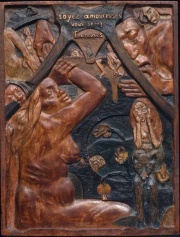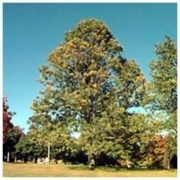Difference between revisions of "Linden"
Jump to navigation
Jump to search
(username removed) |
|||
| (5 intermediate revisions by 2 users not shown) | |||
| Line 1: | Line 1: | ||
| − | [[File:57.582-CR9858-d1.jpg|thumb|]] | + | [[File:57.582-CR9858-d1.jpg|thumb|Carved linden by Gauguin<br>MFA# 57.582]] |
== Description == | == Description == | ||
| − | + | [[File:image6-Basswood.jpg|thumb|Linden]] | |
| − | + | A name for several species of large deciduous trees of the family ''Tilia''. They are known as linden trees in Germany, tilluel trees in France, lime trees in Britain, and basswood trees in North America. The light-brown wood from these trees has a straight grain and is easily worked. Linden wood is used for furniture and cabinets. Because linden wood is soft and workable, it has been used since at least the 1600s for decorative items with intricate carvings such as picture frames and sculptures. | |
== Synonyms and Related Terms == | == Synonyms and Related Terms == | ||
| Line 8: | Line 8: | ||
''Tilia''; lime tree (Br.); basswood (N. America); tilleul (Fr.); tilo (Esp.); tilia (Port.); limewood | ''Tilia''; lime tree (Br.); basswood (N. America); tilleul (Fr.); tilo (Esp.); tilia (Port.); limewood | ||
| − | + | == Physical and Chemical Properties == | |
| − | + | * Pale white to light brown with undefined sapwood/heartwood sections | |
| − | + | * Straight grain with fine, even texture and moderate natural luster | |
| − | + | * Density = 32-40 ppcf | |
| − | |||
| − | |||
| − | == | + | ==Working Properties== |
| + | * Easy to work, being very soft and light. | ||
| + | * One of the most suitable wood species for hand carving. | ||
| + | * Glues and finishes well, but has poor steam bending and nail holding characteristics. | ||
| + | ==Resources and Citations== | ||
| + | * The Wood Database: [https://www.wood-database.com/basswood/ Basswood] | ||
| + | * Wikipedia: https://en.wikipedia.org/wiki/Tilia (Accessed October 13, 2020) | ||
* Ralph Mayer, ''A Dictionary of Art Terms and Techniques'', Harper and Row Publishers, New York, 1969 (also 1945 printing) | * Ralph Mayer, ''A Dictionary of Art Terms and Techniques'', Harper and Row Publishers, New York, 1969 (also 1945 printing) | ||
| − | |||
* Hermann Kuhn, ''Conservation and Restoration of Works of Art and Antiquities'', Butterworths, London, 1986 | * Hermann Kuhn, ''Conservation and Restoration of Works of Art and Antiquities'', Butterworths, London, 1986 | ||
| − | |||
* F. H. Titmuss, ''Commercial Timbers of the World'', The Technical Press Ltd., London, 1965 | * F. H. Titmuss, ''Commercial Timbers of the World'', The Technical Press Ltd., London, 1965 | ||
| − | |||
* ''Van Nostrand's Scientific Encyclopedia'', Douglas M. Considine (ed.), Van Nostrand Reinhold, New York, 1976 | * ''Van Nostrand's Scientific Encyclopedia'', Douglas M. Considine (ed.), Van Nostrand Reinhold, New York, 1976 | ||
| − | |||
* Random House, ''Webster's Encyclopedic Unabridged Dictionary of the English Language'', Grammercy Book, New York, 1997 | * Random House, ''Webster's Encyclopedic Unabridged Dictionary of the English Language'', Grammercy Book, New York, 1997 | ||
| − | |||
* ''The American Heritage Dictionary'' or ''Encarta'', via Microsoft Bookshelf 98, Microsoft Corp., 1998 | * ''The American Heritage Dictionary'' or ''Encarta'', via Microsoft Bookshelf 98, Microsoft Corp., 1998 | ||
| − | |||
* Edward Reich, Carlton J. Siegler, ''Consumer Goods: How to Know and Use Them'', American Book Company, New York City, 1937 | * Edward Reich, Carlton J. Siegler, ''Consumer Goods: How to Know and Use Them'', American Book Company, New York City, 1937 | ||
| − | [[Category:Materials database]] | + | [[Category:Materials database]][[Category:MWG]][[Category: Wood]] |
Latest revision as of 12:20, 2 October 2024
Description
A name for several species of large deciduous trees of the family Tilia. They are known as linden trees in Germany, tilluel trees in France, lime trees in Britain, and basswood trees in North America. The light-brown wood from these trees has a straight grain and is easily worked. Linden wood is used for furniture and cabinets. Because linden wood is soft and workable, it has been used since at least the 1600s for decorative items with intricate carvings such as picture frames and sculptures.
Synonyms and Related Terms
Tilia; lime tree (Br.); basswood (N. America); tilleul (Fr.); tilo (Esp.); tilia (Port.); limewood
Physical and Chemical Properties
- Pale white to light brown with undefined sapwood/heartwood sections
- Straight grain with fine, even texture and moderate natural luster
- Density = 32-40 ppcf
Working Properties
- Easy to work, being very soft and light.
- One of the most suitable wood species for hand carving.
- Glues and finishes well, but has poor steam bending and nail holding characteristics.
Resources and Citations
- The Wood Database: Basswood
- Wikipedia: https://en.wikipedia.org/wiki/Tilia (Accessed October 13, 2020)
- Ralph Mayer, A Dictionary of Art Terms and Techniques, Harper and Row Publishers, New York, 1969 (also 1945 printing)
- Hermann Kuhn, Conservation and Restoration of Works of Art and Antiquities, Butterworths, London, 1986
- F. H. Titmuss, Commercial Timbers of the World, The Technical Press Ltd., London, 1965
- Van Nostrand's Scientific Encyclopedia, Douglas M. Considine (ed.), Van Nostrand Reinhold, New York, 1976
- Random House, Webster's Encyclopedic Unabridged Dictionary of the English Language, Grammercy Book, New York, 1997
- The American Heritage Dictionary or Encarta, via Microsoft Bookshelf 98, Microsoft Corp., 1998
- Edward Reich, Carlton J. Siegler, Consumer Goods: How to Know and Use Them, American Book Company, New York City, 1937

